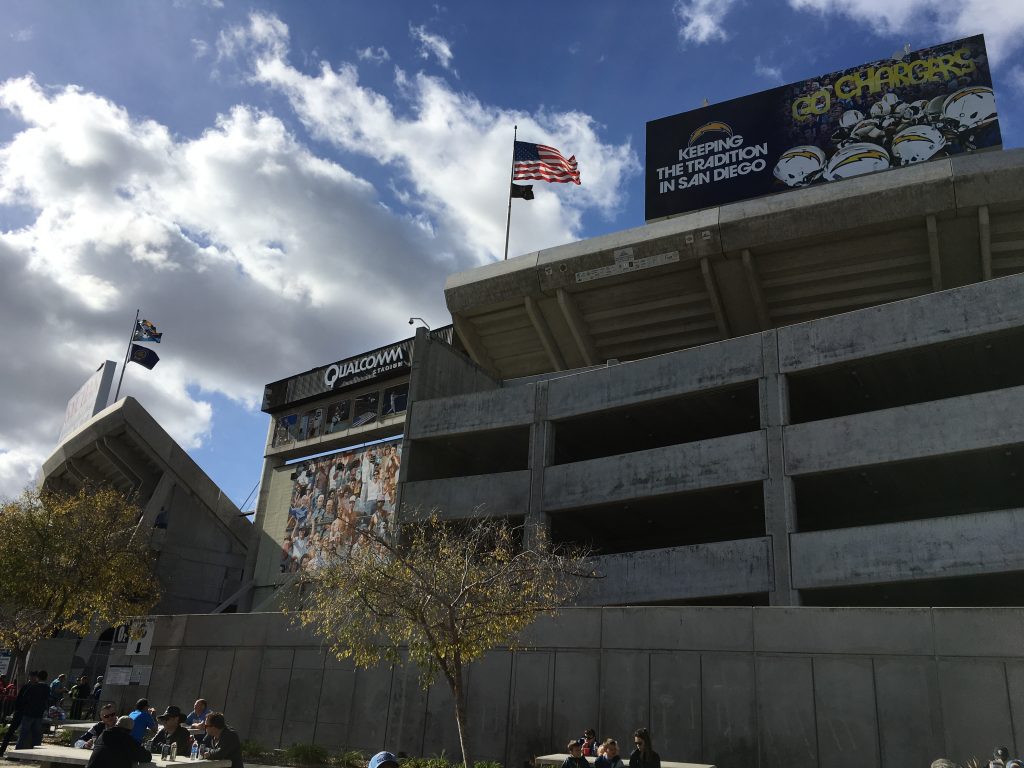The middle of San Diego is going to be the center of the action this fall as Mission Valley’s land surrounding and including where SDCCU Stadium (formerly Qualcomm Stadium) sits. Redevelopment of this site offers one of the last major pieces of city-owned land that is centrally located to most of the city and much of San Diego County.
SoccerCity and SDSU West are two ballot initiatives that have qualified for the November 6, 2018 general election ballot. The reality is that both competing measures are simply a battle of land redevelopment rights among a handful of area developers who want the ability to develop…make that redevelop…a large amount acreage that currently houses an aging sports facility that has long outlived its functionality. One plan, SoccerCity, came along first and all but guarantees that a professional soccer team in the MLS will call San Diego home, if approved. The other plan is not officially sponsored by San Diego State University, but is named SDSU West all but guarantees that SDSU, with frequently-changing details and an uncertain timeline, will be gifted the land to have a handful of developers redevelop land for them over time.
SDSU currently has no financial means to purchase any land, which is why they are playing on the emotional heartstrings of San Diego voters to graciously trust that they are most deserving of the land. SDSU West intends to build student housing and academic facilities as an extension of its currently land-locked campus along with a moderately-sized football stadium to house Aztec games and residential housing units available as part of the project.
FS Investors has provided a detailed plan that promises (but doesn’t have official wording in its 3,000-page initiative) to build a long-sought-after San Diego River Park as part of its vision to provide a new stadium capable of housing both an MLS team and the SDSU Aztecs football team. In addition to building student housing and academic facilities, SoccerCity will have housing and retail components to make the project financially viable.
One project (SoccerCity) is supposed to have more housing units than the other. The other project (SDSU West) is supposed to have a bigger stadium for the SDSU football team than the other. Both projects will increase traffic in that area that is much less busy since the Chargers bolted north. It’s all more than enough to excite and confuse voters at the same time. Each project would need at least 50-percent plus one to pass, and the project with the most overall votes would be considered the winning measure even though voters will be voting on each initiative separately. It is all fairly convoluted and that seems to be the intent.
Both sides should really just sit in the same room and hammer out a plan that each can live with and present to the community. Together they could do what is best for the greater good of San Diego. SoccerCity and SDSU West could create one project that all of San Diego can live with. Given the complexity of community stakeholders involved with a project of this magnitude, it would require compromise and it would work, especially with so many other needs and priorities in the city. Unfortunately, San Diegans will be bombarded with expected multi-million-dollar political campaigns for the competing Mission Valley measures on the airwaves, in the mailboxes and online between Labor Day and Election Day.
What could also happen is that each side beats the other side up enough with misleading information or attack ads leaving neither side with the necessary approval percentage and the city has to go back to square one in terms of setting up a time-consuming RFP (request for proposal) scenario to redevelop this portion of Mission Valley a different way.
It will be interesting to see what develops with this major Mission Valley redevelopment site over the next few months. SoccerCity and SDSU West have their collective work cut out for them to convince San Diego voters that their plan is the best way forward. Marketing a vision requires time, effort and funding. We will all find out on November 6 which plan was marketed better at the ballot box.

Photos by: Patrick Pierce
